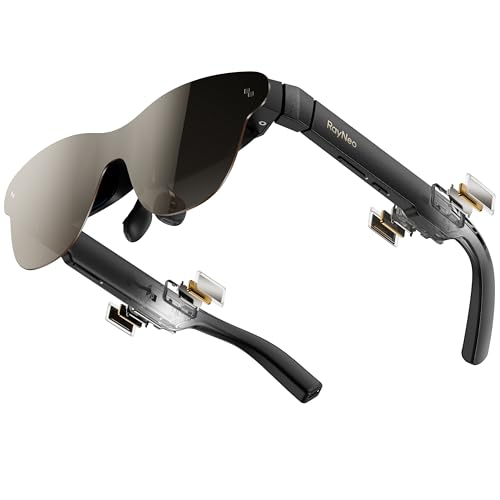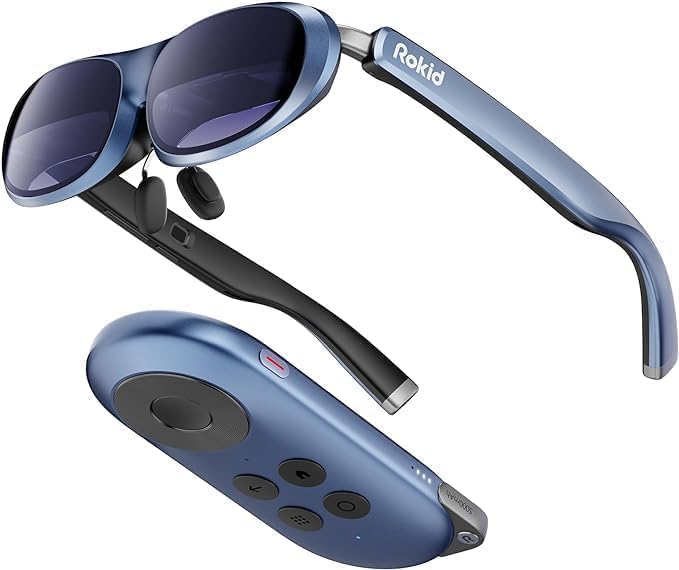Embarking on a journey to enhance my productivity and entertainment, I found myself searching for a solution to the limitations of traditional screens. The cramped workspace and the constant strain on my eyes from staring at small screens for extended periods were becoming increasingly problematic. A larger, more immersive display that could adapt to various situations seemed like the perfect solution, and that’s where the XREAL Air AR Glasses entered the picture. This review details my extended experience with them.
The need for a portable, versatile, and comfortable larger display solution is evident for many. Professionals seeking improved work efficiency, mobile gamers yearning for immersive experiences, and movie buffs desiring a personal cinematic theater all fall into this category. However, the ideal customer profile for AR glasses hinges upon specific needs and preferences. Individuals who rely heavily on precise visual details in their workflow, such as graphic designers or architects, might find the current resolution limitations less than ideal. For those who prioritize absolute portability above all else and don’t mind a less immersive experience, compact portable monitors may be a better choice. Before investing in XREAL Air AR Glasses, consider your primary use case, desired screen size, device compatibility, and budget. These factors will help you determine if this particular technology is the right fit for your lifestyle.
- Welcome to the era of portable display built on cutting edge AR technologies with industry-leading image quality.
- 【Easy On The Eyes】Easy to wear at 79g of weight, TÜV Rheinland-certified eye comfort.
- 【Unlock Spatial Display】Multiple display modes to suit your various needs, unlock spatial display with XREAL Beam.
An In-Depth Look at the XREAL Air AR Glasses
The XREAL Air AR Glasses promise a portable, immersive cinematic and workspace experience. The package includes the glasses themselves, a USB-C cable, a cleaning cloth, a travel case, a light shield, and three types of nose pads. Compared to market leaders, the XREAL Air distinguishes itself with its lightweight and stylish design; however, software maturity remains an area for improvement. The glasses are intended for users seeking a versatile solution for mobile entertainment, work, and casual gaming but are less suited for intense VR gaming experiences or those needing absolute precision in their visual tasks.
- Pros: Lightweight and comfortable design, large virtual screen size, compatibility with various devices, relatively inexpensive compared to competitors.
- Cons: Software can be unstable, limited device compatibility in certain modes (especially with older devices), can get hot near the USB-C connection point, some users report discomfort after extended wear.
- [World’s Brightest AR Glasses – 1,200 Nits] RayNeo Air 3s Pro smart AR glasses — now with an upgraded 1,200 nits to-eye brightness, the highest in any AR glasses today. Even the faintest stars...
- [HueView Display Technology] RayNeo Air 3s features the advanced HueView micro-OLED screen with 98% DCI-P3, △E<2 color accuracy, and 200,000:1 contrast. Enjoy a 201" virtual screen and 145% sRGB...
- Rokid Joy AR glasses set, the world's first streaming & gaming AR glasses, bridge the gap with the future through AR glasses and streaming box, carry a world of big-screen movies and games wherever...
Exploring the Features and Benefits of the XREAL Air
Display Technology and Image Quality
The XREAL Air boasts Micro-OLED displays with a claimed 201-inch virtual screen, providing a sharp and clear image, especially for movies and games. The colors are vibrant and the contrast is good. However, text can appear fuzzy at the edges, especially at the periphery of the screen. This makes them less ideal for extended periods of reading or detailed work involving text. The resolution is sufficient for most uses but may not be optimal for tasks demanding extremely high visual fidelity. The reported 120hz refresh rate is not consistently achievable across all devices, leading to some inconsistencies in smoothness. While the virtual screen size is impressive, personal experiences will vary based on individual eyesight and viewing distances.
Comfort and Wearability
The lightweight design (around 79g) makes the XREAL Air comfortable for short to moderate periods of use. Many users find them easier to wear for extended periods than bulkier VR headsets. However, a common complaint among users is pressure points around the ears, particularly on the right side where the USB-C cable connects. This can cause discomfort, and some users resort to modifications like adding foam padding to alleviate this issue. The nose pads provide some customizability, but finding the perfect fit can be crucial for preventing discomfort.
Connectivity and Compatibility
The glasses’ compatibility varies depending on the intended use mode (Air Casting, Virtual Desktop, or AR Space). While the Air Casting mode works well with most smartphones and PCs, the Virtual Desktop and AR Space modes have more stringent requirements. For example, the Virtual Desktop mode currently has limited support for M1/M2 MacBooks, with Windows support promised soon. AR Space mode requires specific Android phones and the XREAL Nebula app. The lack of widespread compatibility across all devices is a significant drawback. The reliance on a connected device is a limitation – the XREAL Air doesn’t have its own processing unit or battery, which can impact battery life of the source device and adds to the bulk.
Software and App Ecosystem
The XREAL Nebula app plays a crucial role in the user experience. However, user reviews highlight inconsistencies, occasional crashes, and a lack of maturity, particularly on the Mac/iOS side. The software’s feature set is growing, but its current state of development is far from perfect. This makes the AR features less user-friendly than they could be. While functionality exists to achieve the desired outcomes, a more refined and polished software experience would drastically enhance the overall satisfaction.
Overall Performance and Value
The XREAL Air AR Glasses offer a compelling value proposition for users primarily focused on consuming media, gaming casually, or using them as a portable external display. The lightweight design, large virtual screen size, and compatibility with several devices are its key strengths. However, software instability, limited compatibility in certain modes, and potential comfort issues are significant drawbacks. Whether these are dealbreakers will depend heavily on individual needs and tolerance for technological imperfections.
User Feedback: A Chorus of Voices
Extensive online research reveals a diverse range of user experiences. While many praise the glasses’ lightweight design and immersive display for gaming and video consumption, several highlight software instability and comfort issues as major concerns. Some users have expressed frustration with the limited device compatibility and occasional screen fuzziness. However, the company’s responsiveness to user feedback and ongoing software development indicate a commitment to improvement.
Concluding Thoughts: Is the XREAL Air Right for You?
The XREAL Air AR Glasses offer a unique blend of portability, immersion, and affordability. They address the need for a larger screen in various settings. However, potential buyers should be aware of the software’s limitations, device compatibility issues, and potential comfort concerns. If these drawbacks aren’t major deterrents, and your primary use case aligns with media consumption or casual gaming, the XREAL Air might be a good fit. If you’re seeking a flawless, feature-rich experience, however, you may want to wait for future iterations or consider alternative solutions. To see if the XREAL Air AR Glasses are right for you, click here to check them out.
Last update on 2025-11-05 / Affiliate links / Images from Amazon Product Advertising API




